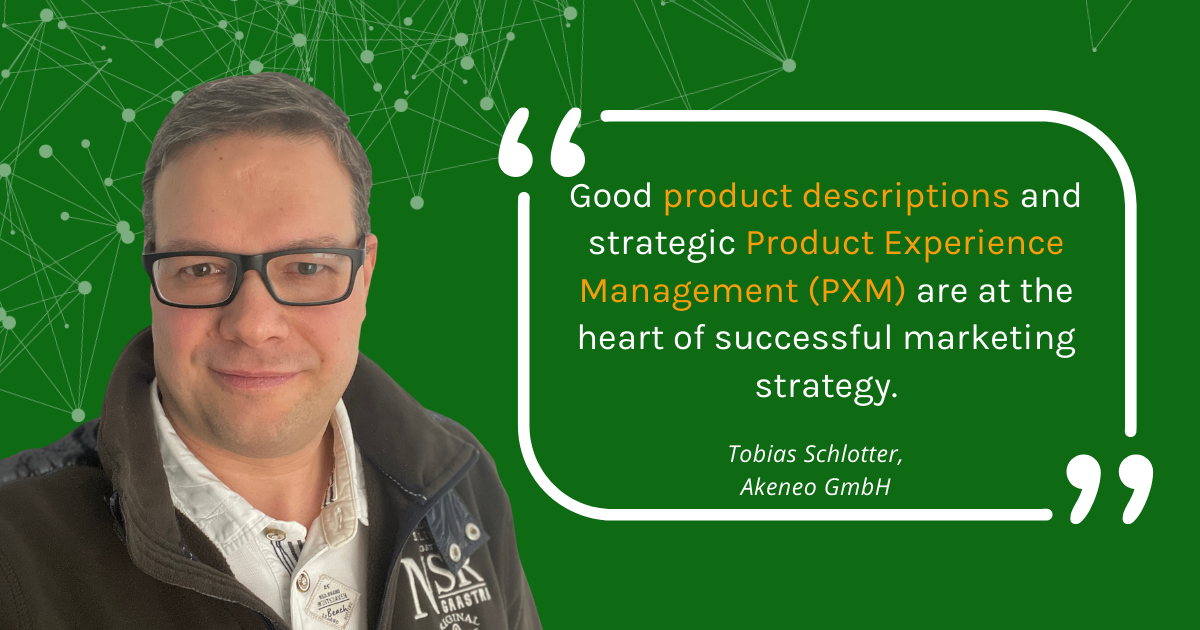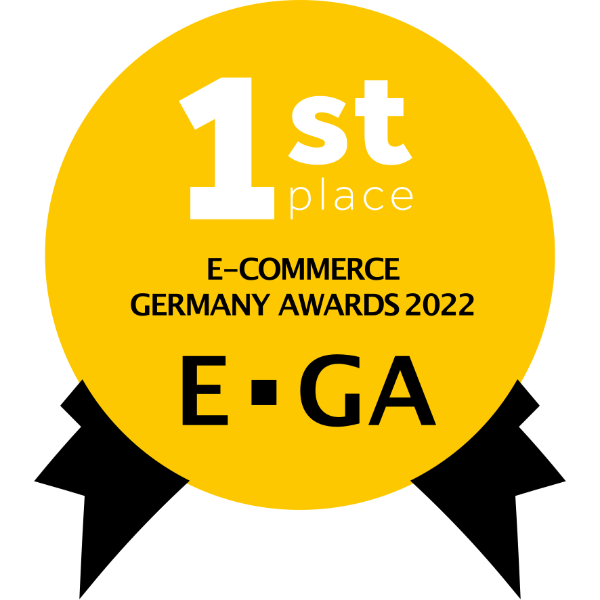
The Importance of Product Experience Management (PXM) - Interview with Tobias Schlotter
Akeneo, that is one of the world's leading providers of PXM solutions. My name is Tobias Schlotter and I have been responsible for Akeneo's DACH region and Eastern European business for five years.
Since 2012, we have grown into an international company with locations in France, Germany, the UK, Australia and the USA. As a best-of-breed enterprise open source software and company, we meet all the critical success criteria and, together with the largest ecosystem in the PIM industry, we are fully committed to the success of our 400+ enterprise customers and the user feedback behind more than 80,000 community installations worldwide.
What exactly is product experience management (PXM), a term that you coined at Akeneo, but which is now also omnipresently recited by Gartner, Forrester and others?
Customer experience has become the centerpiece of modern marketing strategies - and the biggest differentiator for brands and retailers in a crowded marketplace. However, accurate content and precise information have long since ceased to be sufficient for a good customer experience. Customers want to be delighted at all touchpoints and expect a consistent and end-to-end brand experience. A great customer experience starts with the presentation of products, and if you think about it, this is where you need to score points, right? This is where companies can gain a real competitive advantage by following a strategic Product Experience Management (PXM) approach. Context-based product information forms the basis for this, as it places the customer at the center of every interaction.
Numerous providers, brands, companies and retailers compete online for the attention of their target group. Anyone who wants to win customers today must offer far more than just advertising. It is also no longer enough to simply put your portfolio on the web or to make your web presence mobile friendly. Customers' demands are much higher: they expect to be able to shop easily at any time of day - anywhere and using a wide variety of end devices.
Millennials, for example, want maximum service and inform themselves thoroughly about the product and alternatives before making a purchase. Both B2C and B2B manufacturers and retailers need to keep up with this new buyer behavior - and we see every day that this is not a vague picture of the future. Already today, outstanding product experiences are the basis for differentiation.... This was ultimately shown by our survey "Product Experience Management around the World: How B2B vendors manage their product experience to meet customers' expectations" (1,600 participants in 7 countries). In it, 97% confirmed that they see product information as a key tool for improving the customer experience.
Why is this so significant, especially for the coming year?
True digital transformation is in full swing across industries and is now hitting the last digital holdout hard - the current situation has accelerated this process even further. Almost all companies are now focusing more on selling their products online.
Consistent and contextual product information has become essential to get noticed in the new Digital Experience Economy. However, without a compelling Product Experience, there will be no outstanding Customer Experience. And the Customer Experience created today will determine the losers and winners of tomorrow!
Especially digitally, completeness, comprehensibility and trustworthiness of product information are critical to successfully address buyers. Many companies are realizing this right now. To put it simply: In the store I can look at the product and try it out - via the screen I have to fall back on all this information - and manufacturers / retailers who score even better here can, for example, use additional information that integrates the product into a "story" and design touchpoints in such a way that they complement each other perfectly. This is exactly what makes Product Experience Management (PXM) champions.
The customer experience is the sum of the experiences that the customer has in connection with the company. The term allows for a great deal here, because it is about the sum of the individual parts.
Some companies spend a lot of money on just one part of the "experience" - e.g. for the acquisition of new customers (via the brand image) or the care of existing customers via services - and these also contribute to the experience. However, we see time and again that companies do not score as well as they could in product communication because they do not have their product experience under control. Put simply, they've spent a lot of money on advertising and attention and potential customers find out about the product only to be confused or not even understand if it's right for them. The picture in the store is wrong, the description is boring, full of spelling mistakes and there are no measurements at all - so how is the customer supposed to know if the product fits their needs?
Of course, this is an exaggeration - but isn't that exactly where many companies need to score points? In the presentation of their own products? That's why we say that there can be no successful customer experience without an outstanding product experience.
In addition to service, the target group must also be provided with content that inspires them and appeals to them emotionally. The customer wants to be informed, inspired and entertained. Strategic content marketing generates recognition value, trust, credibility, loyalty and authenticity. The brand remains in the customer's memory, the experience becomes an experience.
Good content is also an ideal way to identify customer preferences more quickly and improve products. Social media interaction, downloads, likes and shares, quickly reveal the interests and preferences of the target group. This allows the provider to get to know the customer better and optimize its products accordingly. This, in turn, promotes brand-customer ties and increases sales.
So it's not just about managing customer interaction, it's about designing the product experience to meet or exceed expectations.
The total package, the customer experience, determines the success of a brand. To create the best possible experience for the customer, this user experience must take center stage.
A unique customer experience results from a mix that ensures the greatest possible attention from the relevant target group: It can be composed of interactions on social media platforms, individual newsletters, personal greetings on the website, or the chatbot that answers the questions of prospective customers 24/7.
All these touchpoints create a personalized experience and strengthen the bond with the customer. Today, the latter switches seamlessly between channels and end devices. This blurs the boundaries between e-commerce and point of sale: the customer reaches the brand with a click on an ad and then switches to the website and finally to the store.
And what does the future of customer experience look like?
Innovations are advancing. If you want to continue to offer an optimal customer experience in the future, you need to keep pace with current trends.
Currently, more than half of global e-commerce takes place on mobile devices. Users surf the Internet, research products or buy them directly on their smartphones. Here, it is essential to further refine the product experience - by adapting product data to different specifications and formats and preparing for the increasing dominance of mobile apps.
Another trend is voice-activated smart devices such as Amazon Echo or Google Home. Product data must therefore be prepared in such a way that it can be found via search with these devices. Verbal interaction is very different from a search query via text. Voice queries are usually at least 15 words long and often start with words like "where," "how," and "what." Product data must therefore be contextualized for voice activation in order to exploit the potential of this sales channel.
AR and VR technologies are also gaining ground. This allows brands to show their customers how they will see and experience the products in the real world - without having to go to the store. The application for machine learning and AI is also predicted to grow strongly in 2019. Thanks to these technologies, companies will be able to offer their customers exactly what they want in the shortest possible time with little effort. The greater personalization that this enables allows companies to improve product recommendations and further optimize the user experience.
So PIM is needed as a tool and PXM as a strategy for perfect brand experiences?
Exactly! In order to adapt to the needs of the customer and to be able to provide an optimal user experience across media, companies and retailers need highly structured and consistent product information.
A product information management system (PIM) is ideal for managing and enriching this data. It not only facilitates the collection and maintenance of product data and its provision to various channels and media. Data maintenance and entry become more efficient, manual effort decreases, while data quality increases and the error rate is reduced. With a PIM, it is also possible to manage data in a media-neutral manner. The system also helps to differentiate consistent product information by sales channel or location.
With a PIM, product data from various systems and sources is first collected in raw format. In the next step, they are consolidated and standardized, then enriched and thus improved. For this purpose, attributes are compiled, the products are categorized, and digital assets such as images are added. Now the data can be adapted to the context, such as channels and locations, and targeted to specific markets. At the end of the process, there is a complete as well as customized data catalog that can be marketed across all channels.
This context-based information is the future. They form the basis for product experience management solutions. Moving away from pure data management, real, expressive and unique brand and product experiences are developed and delivered. It allows the right information to reach the right person, through the right channel, at the right time. They put the customer at the center of every interaction and resulting transaction.
With the next generation of product experience management solutions, offers can be presented with the required context-based information across channels. This enables brands to further optimize their omnichannel customer experiences. PXM helps marketers and sales teams orchestrate and market product information across multiple contexts as easily and efficiently as possible.
The outstanding product experiences created in this way reward customers with purchases. Conversion rates and sales increase. Through the positive and consistent shopping experience on all channels, the customer builds an emotional bond and thus brand loyalty. And thanks to optimal product information, the customer is precisely informed - thus reducing the number of incorrect purchases and returns.
In general, products can be marketed more quickly with good PXM - this also increases the speed of market launches, which is essential for seasonal products and promotions.
There are many PIM systems on the market. What are the advantages of Akeneo or in other words: Why should a company rely on Akeneo PIM?
That's right: PIM systems are not exactly few and far between. What has made us - Akeneo - successful for years is the commitment to our core values, with which we inspire the market: usability for our users, scalability, flexibility (as an open source provider) and a solid, comprehensive ecosystem of technology and integration partners. Almost all of our customers mention that we provide an exceptionally intuitive system and that this makes a big difference in their daily work. Many users have even become real fans by using Akeneo, which is certainly not only due to our mascot "Ziggy".


